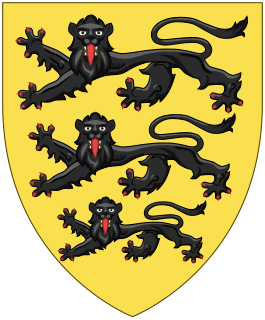 W
WThe Hohenstaufen, also called Staufer, was a noble dynasty of unclear origin that rose to rule the Duchy of Swabia from 1079 and to royal rule in the Holy Roman Empire during the Middle Ages from 1138 until 1254. The most prominent kings Frederick I (1155), Henry VI (1191) and Frederick II (1220) ascended the imperial throne and also ruled Italy and Burgundy. The non-contemporary name is derived from a family castle on the Hohenstaufen mountain at the northern fringes of the Swabian Jura near the town of Göppingen. Under Hohenstaufen reign the Holy Roman Empire reached its greatest territorial extent from 1155 to 1268.
 W
WAgnes of Waiblingen, also known as Agnes of Germany, Agnes of Poitou and Agnes of Saarbrücken, was a member of the Salian imperial family. Through her first marriage, she was Duchess of Swabia; through her second marriage, she was Margravine of Austria.
 W
WAnna of Hohenstaufen, born Constance, was an Empress of Nicaea. She was a daughter of Frederick II, Holy Roman Emperor and Bianca Lancia.
 W
WThe Barbarossa Chandelier was made on the order of Emperor Frederick I, nicknamed Barbarossa, and his wife Beatrice sometime between 1165 and 1170 and was installed under the cupola of the Palatine Chapel in Aachen Cathedral. The chandelier was a donation in honour of Mary, Mother of God, the patroness of Aachen Cathedral and simultaneously represented a tribute to the builder of the cathedral, Charlemagne.
 W
WBeatrice or Beatrix of Swabia, a member of the Hohenstaufen dynasty, was Holy Roman Empress and German Queen in 1212 as the first wife of the Welf emperor Otto IV. She was also the shortest-serving Holy Roman Empress, dying three weeks into her marriage.
 W
WBeatrix of Sicily or Beatrice di Sicilia was a Sicilian princess, daughter of the King Manfred of Sicily and his wife Helena Angelina Doukaina. In 1296 she became Marchioness consort of Saluzzo.
 W
WBerengaria was queen regnant of Castile in 1217 and queen consort of León from 1197 to 1204. As the eldest child and heir presumptive of Alfonso VIII of Castile, she was a sought after bride, and was engaged to Conrad, the son of Holy Roman Emperor Frederick I Barbarossa. After his death, she married her cousin, Alfonso IX of León, to secure the peace between him and her father. She had five children with him before their marriage was voided by Pope Innocent III.
 W
WBianca Lancia d'Agliano was an Italian noblewoman. She was the mistress and later the last wife of the Hohenstaufen emperor Frederick II. The marriage was conducted while she was on her deathbed, therefore it was considered non-canonical.
 W
WConrad III of the Hohenstaufen dynasty was from 1116 to 1120 Duke of Franconia, from 1127 to 1135 anti-king of his predecessor King Lothair III and from 1138 until his death in 1152 King in the Holy Roman Empire. He was the son of Duke Frederick I of Swabia and Agnes, a daughter of the Salian Emperor Henry IV.
 W
WConrad, a member of the Hohenstaufen dynasty, was the only son of Emperor Frederick II from his second marriage with Queen Isabella II of Jerusalem. He inherited the title of King of Jerusalem upon the death of his mother in childbed. Appointed Duke of Swabia in 1235, his father had him elected King of Germany and crowned King of Italy in 1237. After the emperor was deposed and died in 1250, he ruled as King of Sicily until his death.
 W
WConrad, called the Younger or the Boy, but usually known by the diminutive Conradin, was the last direct heir of the House of Hohenstaufen. He was Duke of Swabia (1254–1268) and nominal King of Jerusalem (1254–1268) and Sicily (1254–1258). After his attempt to reconquer Sicily failed, he was caught and beheaded.
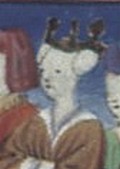 W
WConstance II of Sicily was Queen consort of Aragon as the wife of Peter III of Aragon and a pretender to the Kingdom of Sicily from 1268 to 1285. She was the only daughter of Manfred of Sicily and his first wife, Beatrice of Savoy.
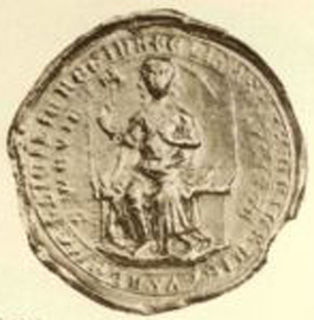 W
WElisabeth of Bavaria, a member of the House of Wittelsbach, was Queen consort of Germany from 1246 to 1254 by her marriage to King Conrad IV of Germany.
 W
WElisabeth of Swabia, was a member of the House of Hohenstaufen who became queen of Castile and Leon by marriage to Ferndinand III.
 W
WEnzo was an illegitimate son of the Hohenstaufen emperor Frederick II, who appointed him 'King of Sardinia' in 1238. He played a major role in the wars between Guelphs and Ghibellines in the Imperial kingdom of Italy, and was captured by his enemies in 1249. He remained imprisoned in Bologna until his death.
 W
WFrederick Barbarossa, also known as Frederick I, was the Holy Roman Emperor from 1155 until his death 35 years later. He was elected King of Germany at Frankfurt on 4 March 1152 and crowned in Aachen on 9 March 1152. He was crowned King of Italy on 24 April 1155 in Pavia and emperor by Pope Adrian IV on 18 June 1155 in Rome. Two years later, the term sacrum ("holy") first appeared in a document in connection with his empire. He was later formally crowned King of Burgundy, at Arles on 30 June 1178. He was named Barbarossa by the northern Italian cities which he attempted to rule: Barbarossa means "red beard" in Italian; in German, he was known as Kaiser Rotbart, which has the same meaning. The prevalence of the Italian nickname, even in later German usage, reflects the centrality of the Italian campaigns to his career.
 W
WFrederick II was King of Sicily from 1198, King of Germany from 1212, King of Italy and Holy Roman Emperor from 1220 and King of Jerusalem from 1225. He was the son of emperor Henry VI of the Hohenstaufen dynasty and of Constance, heiress to the Norman kings of Sicily.
 W
WFrederick II was the regent of the Kingdom of Sicily from 1291 until 1295 and subsequently king of Sicily from 1295 until his death. He was the third son of Peter III of Aragon and served in the War of the Sicilian Vespers on behalf of his father and brothers, Alfonso ΙΙΙ and James ΙΙ. He was confirmed as king by the Peace of Caltabellotta in 1302. His reign saw important constitutional reforms: the Constitutiones regales, Capitula alia, and Ordinationes generales.
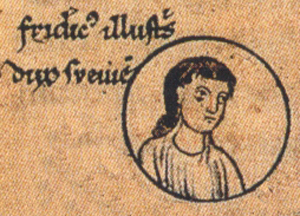 W
WFrederick IV of Hohenstaufen (1145–1167) was duke of Swabia, succeeding his cousin, Frederick Barbarossa, Holy Roman Emperor, in 1152.
 W
WFrederick of Antioch was an Italian nobleman who served as the imperial vicar of Tuscany from 1246 to 1250. He was an illegitimate son of the Frederick II, Holy Roman Emperor, and an unidentified southern Italian noblewoman. He took part in the wars of the Guelphs and Ghibellines in northern Italy, and in the war over the Kingdom of Sicily following his father's death (1250).
 W
WGertrude of Sulzbach was German queen from 1138 until her death as the second wife of the Hohenstaufen king Conrad III.
 W
WHenry VI, a member of the Hohenstaufen dynasty, was King of Germany from 1169 and Holy Roman Emperor from 1191 until his death. From 1194 he was also King of Sicily.
 W
WHenry (VII), a member of the Hohenstaufen dynasty, was King of Sicily from 1212 until 1217 and King of Germany from 1220 until 1235, as son and co-ruler of Emperor Frederick II. He was the seventh Henry to rule Germany, but in order to avoid confusion with the Luxembourg emperor Henry VII, he is usually numbered Henry (VII).
 W
WThe Imperial Cross is part of the Imperial Regalia of the Holy Roman Empire. It served as the container for the two "Great Relics of Christ" : the Holy Lance in its horizontal arms and the reliquary of the True Cross in the lower shaft. It is thus the original reliquary of the Imperial relics. The Imperial cross is kept in the Imperial Treasury in the Hofburg.
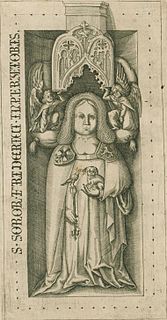 W
WJudith of Hohenstaufen, also known as Judith of Hohenstaufen or Judith of Swabia, a member of the Hohenstaufen dynasty, was Landgravine of Thuringia from 1150 until 1172 by her marriage with the Ludovingian landgrave Louis II. She was baptized as Judith, but was commonly called Jutta or Guta. Sometimes the Latinate form Clementia was used, or Claritia or Claricia.
 W
WManfred was the last King of Sicily from the Hohenstaufen dynasty, reigning from 1258 until his death. The natural son of the Holy Roman Emperor Frederick II, Manfred became regent over the kingdom of Sicily on behalf of his nephew Conradin in 1254. As regent he subdued rebellions in the kingdom, until in 1258 he usurped Conradin's rule. After an initial attempt to appease pope Innocent IV he took up the ongoing conflict between the Hohenstaufens and the papacy through combat and political alliances. He defeated the papal army at Foggia on 2 December 1254. Excommunicated by three successive popes, Manfred was the target of a Crusade (1255–66) called first by Pope Alexander IV and then by Urban IV. Nothing came of Alexander's call, but Urban enlisted the aid of Charles of Anjou in overthrowing Manfred. Manfred was killed during his defeat by Charles at the Battle of Benevento, and Charles assumed kingship of Sicily.
Margaret of Austria, a member of the House of Babenberg, was German queen from 1225 until 1235, by her first marriage with King Henry (VII), and Queen of Bohemia from 1253 to 1260, by her second marriage with King Ottokar II.
 W
WMargaret of Sicily was a Princess of Sicily and Germany, and a member of the House of Hohenstaufen. By marriage she was Landgravine of Thuringia and Countess Palatine of Saxony.
 W
WOtto I was Count of Burgundy from 1190 to his death and briefly Count of Luxembourg from 1196 to 1197. He was the fourth son of Frederick I, Holy Roman Emperor, by his second wife Beatrice I, Countess of Burgundy, daughter of Count Renaud III.
 W
WOtto of Freising was a German churchman and chronicler. He was Otto I Bishop of Freising as from 1138.